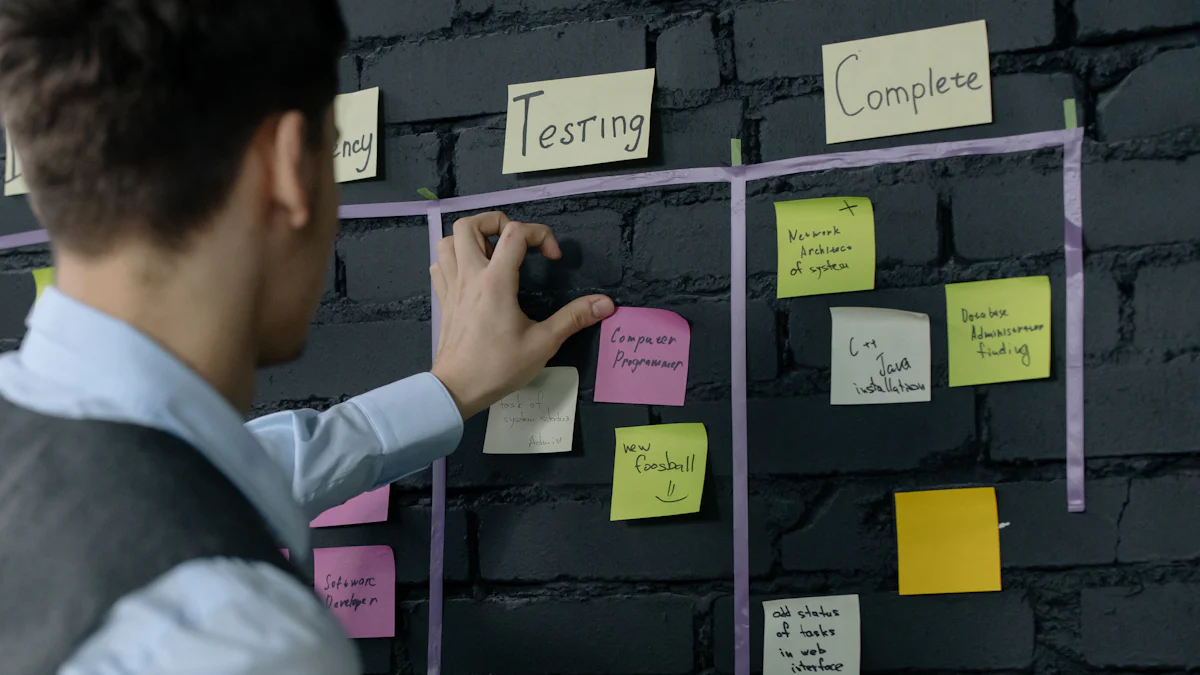Key Responsibilities of Software Engineers and Developers
Try Aihirely for
Smarter Interview Prep
Experience real-time AI support tailored to your Resume.
Boost your confidence and ace every question with
AI Mock Interview.

Image Source: pexels
The comparison of software engineer vs developer highlights the vital roles these professionals play in shaping the digital world. You rely on their expertise to create, maintain, and improve the software that powers everything from mobile apps to enterprise systems. Whether it’s a software engineer or developer, their responsibilities include designing secure applications, automating tasks, and enhancing user experiences.
The demand for software engineer vs developer roles continues to grow. Companies need experts to develop cloud-compatible applications, build automation tools, and adopt emerging technologies like AI and IoT. As businesses embrace digital transformation, the distinction between software engineer vs developer becomes increasingly important in driving innovation and ensuring systems run smoothly and securely.
Key Takeaways
-
Software engineers plan and manage big systems, focusing on structure and speed.
-
Software developers create apps by writing, testing, and fixing code to meet user needs.
-
Teamwork is important; both jobs work with others to meet goals and improve software.
-
Knowing coding languages and tools is needed to do well in both jobs.
-
Always learning and staying flexible helps in the quickly changing tech world.
Software Engineer vs Developer

Image Source: pexels
Defining Software Engineers
You might think of software engineers as the architects of the tech world. They design, develop, and maintain complex systems by applying engineering principles. Their work often involves creating large-scale software solutions that meet specific requirements. Software engineers focus on the big picture, ensuring that systems are efficient, scalable, and secure. They collaborate with teams to conduct feasibility studies, plan system architecture, and integrate software with existing infrastructure.
To excel in this role, you need a strong foundation in programming languages like Java, Python, or C++. Skills in object-oriented design, problem-solving, and attention to detail are also essential. Many software engineers hold a bachelor’s degree in computer science or a related field, but certifications like AWS Certified Developer or Microsoft Certified: Azure Fundamentals can also help you stand out.
Defining Software Developers
Software developers bring ideas to life by building the core functionality of applications. They focus on coding, testing, and debugging software based on stakeholder specifications. Developers often work on smaller teams or even individually, creating user-friendly applications tailored to specific needs.
If you aim to become a software developer, you’ll need expertise in coding languages such as Python, Java, or Scala. Familiarity with database architecture, Agile project management, and cloud computing will also give you an edge. While a degree in computer science is common, many developers succeed through coding bootcamps or certifications like the Certified Software Development Professional (CSDP).
Key Differences Between the Two Roles
The roles of software engineer vs developer differ in scope and responsibilities. Software engineers focus on high-level system design and architecture, while developers concentrate on building specific features or applications. Engineers often manage teams and oversee project specifications, requiring leadership and project management skills. Developers, on the other hand, specialize in coding and testing, often working on smaller projects.
Here’s a quick comparison:
| Aspect | Software Developer | Software Engineer |
|---|---|---|
| Scope of Work | Focus on building specific features or applications | Focus on high-level system design and architecture |
| Responsibilities | Program, build, test, debug applications | Design, plan, test, deploy complex systems |
| Educational Background | Vocational training, coding bootcamps, or degrees | Typically a four-year degree in computer science |
| Skills Focus | Specialized skills in coding languages and frameworks | Advanced concepts like algorithms and systems design |
| Average Salary | $78,000 per year | $93,000 per year |
| Career Growth | Limited senior roles | More senior-level architecture and leadership roles |
Understanding these differences can help you decide which path aligns with your interests and career goals.
Shared Responsibilities in Software Development
Writing, Testing, and Debugging Code
Both software engineers and developers share the critical task of writing, testing, and debugging code. You play a vital role in creating applications for desktop, web, mobile, and cloud platforms. Writing clean and efficient code ensures that the software performs as intended. Testing and debugging help identify and resolve issues, improving the overall functionality.
To excel in these tasks, you should follow best practices. For example, load and performance testing can help you identify bottlenecks in applications with high user traffic. Security testing protects against vulnerabilities, while usability testing ensures the software meets user needs. Regression testing confirms that updates do not disrupt existing features. When debugging, you should document your process, address compiler warnings, and seek external perspectives when needed. These steps ensure a robust and reliable product.
Collaborating with Teams Across Functions
Collaboration is essential in software development. You often work with cross-functional teams, including product managers, UI/UX designers, and other developers. Clear communication helps align objectives and ensures everyone understands their roles. Using tools like version control systems and issue trackers can streamline project management and maintain transparency.
Adopting an agile mindset allows you to embrace iterative development and continuous feedback. Diversity within teams fosters innovation by bringing varied perspectives to problem-solving. By staying open to new ideas and demonstrating flexibility, you contribute to a more cohesive and productive team environment.
Ensuring Software Quality and Performance
Maintaining software quality and performance is a shared responsibility. You achieve this through rigorous testing and adherence to quality standards. Quality Assurance (QA) focuses on preventing errors during development, while Quality Control (QC) ensures the final product meets requirements.
Various testing methods, such as A/B testing and user testing, help you evaluate software performance and user satisfaction. Concept testing and market testing provide valuable insights into customer preferences. By prioritizing these practices, you ensure the software remains stable, user-friendly, and aligned with business goals.
Unique Responsibilities of Software Engineers
System Design and Architecture
As a software engineer, you play a key role in designing and structuring software systems. This responsibility involves creating frameworks that ensure the software is scalable, efficient, and reliable. You collaborate with software architects to address design challenges and refine system architecture. Your tasks often include:
-
Writing high-quality code that aligns with the architect’s design.
-
Testing software functionalities to identify and fix issues.
-
Optimizing performance to handle increasing user demands.
-
Documenting architectural decisions for future reference.
By focusing on these areas, you ensure the software meets both technical and business requirements. Your ability to think critically and solve design-related problems directly impacts the success of the project.
Applying Engineering Principles
You approach problem-solving like an engineer. This means breaking down complex challenges into manageable parts and finding innovative solutions. To do this effectively, you:
-
Identify the core problem and analyze its components.
-
Question assumptions to uncover hidden issues.
-
Develop solutions based on fundamental principles.
Sketching ideas early in the process helps you save time and resources. Writing also sharpens your thinking, allowing you to explore solutions more thoroughly. Collaboration with peers provides valuable feedback, ensuring your approach is well-rounded. Prototyping and testing your solutions before full implementation reduce risks and improve outcomes.
Managing Complex Projects and Infrastructure
Handling large-scale projects and infrastructure requires you to juggle multiple responsibilities. You manage teams, communicate with stakeholders, and oversee technical systems. Some challenges you face include:
-
Organizing and leading diverse project teams.
-
Ensuring smooth communication between team members and clients.
-
Synchronizing code deployment across systems.
-
Addressing unexpected issues with APIs and third-party services.
Each project presents unique challenges, from changing requirements to unforeseen technical hurdles. Your ability to adapt and maintain precision ensures the project stays on track. By focusing on collaboration and careful planning, you overcome these complexities and deliver high-quality results.
Unique Responsibilities of Software Developers
Creating User-Centric Applications
As a software developer, your primary goal is to create applications that meet user needs and expectations. A user-centric approach ensures that the software is intuitive, accessible, and enjoyable to use. To achieve this, you focus on several key activities:
-
User Research: Gather insights into user behavior, preferences, and challenges through surveys, interviews, and observations.
-
Prototyping: Develop interactive prototypes to visualize ideas and collect feedback from users.
-
Usability Testing: Test the software with real users to identify pain points and areas for improvement.
-
Iterative Design: Continuously refine the application based on user feedback and testing results.
-
Accessibility: Ensure the software is inclusive and adheres to accessibility standards, making it usable for individuals with disabilities.
By prioritizing these practices, you create applications that resonate with users and deliver a seamless experience. Companies like SGS Technologie emphasize understanding the target audience and conducting rigorous usability testing to ensure their products meet user expectations.
Prototyping and Iterating Features
Prototyping and iteration are essential steps in software development. These processes allow you to refine features and address potential issues early. The typical workflow includes:
-
Testing the prototype with users: Gather feedback on the design and functionality.
-
Analyzing feedback and making revisions: Adjust features to improve usability and performance.
-
Repeating the cycle until the final product is achieved: Continue refining until the software meets user needs.
This iterative approach offers several benefits. It enables quick feedback and adjustments, helping you identify and fix bugs early. It also ensures the final product delivers an exceptional user experience. Breaking development into smaller stages allows you to focus on each feature, making the process more efficient and user-focused.
Collaborating with Designers and Product Teams
Collaboration plays a vital role in your success as a software developer. You work closely with designers and product teams to align on project goals and deliver a cohesive product. Effective collaboration involves:
-
Open communication to ensure everyone stays aligned.
-
Sharing knowledge and solving problems collectively.
-
Maintaining mutual respect to foster a positive team environment.
Remote work and diverse team backgrounds can sometimes create challenges. Regular communication and conscious efforts to stay aligned help overcome these obstacles. By working together, you ensure the final product reflects the combined expertise of all team members, resulting in a well-rounded and polished application.
Tip: Strong collaboration skills not only improve project outcomes but also enhance your ability to work in dynamic, cross-functional teams.
Skills for Success in Both Roles
Technical Skills
Mastery of Programming Languages
To excel as a software engineer or developer, you need a strong command of programming languages. JavaScript remains one of the most in-demand languages, with 62% of developers using it according to Stack Overflow’s 2024 Developer’s Survey. Its versatility allows you to work on both front-end and back-end development, while its interactivity enhances web applications. Other essential languages include Python, Java, C, C++, and Scala. Each language offers unique strengths, so mastering multiple languages broadens your opportunities and equips you to tackle diverse projects.
Proficiency in Development Tools
Development tools streamline your workflow and improve productivity. Tools like Git for version control help you manage code changes efficiently. Integrated Development Environments (IDEs) such as Visual Studio Code or IntelliJ IDEA provide features like debugging and syntax highlighting, making coding more manageable. Familiarity with testing frameworks and automation tools also ensures your software meets quality standards. By mastering these tools, you enhance your ability to deliver reliable and efficient solutions.
Understanding Databases and APIs
Databases and APIs form the backbone of many software applications. You should understand how to design, query, and manage databases to store and retrieve data effectively. Knowledge of SQL and NoSQL databases, such as MySQL and MongoDB, is crucial. APIs enable communication between different software systems. Learning how to integrate APIs allows you to add functionality like payment processing or social media sharing to your applications. This skill is vital for creating scalable and feature-rich software.
Soft Skills
Communication and Teamwork
Clear communication and effective teamwork are essential for success. When you communicate well, you reduce errors and improve efficiency. Teamwork fosters creativity and skill-sharing, leading to better solutions. Collaboration also builds trust and creates a positive work environment. These skills help you align with your team’s goals and contribute to a productive workflow.
Problem-Solving and Critical Thinking
Problem-solving and critical thinking enable you to tackle complex challenges. You break down problems into smaller parts, analyze them, and develop innovative solutions. An analytical mindset helps you optimize code performance and identify potential issues early. These skills are invaluable for delivering high-quality software that meets user needs.
Adaptability and Lifelong Learning
The tech industry evolves rapidly, so staying adaptable is crucial. You must embrace new tools, languages, and methodologies to remain competitive. Lifelong learning ensures you keep up with trends and advancements. Whether through online courses, certifications, or hands-on projects, continuous learning helps you grow and succeed in your career.
Tip: Combining technical expertise with strong soft skills makes you a well-rounded professional, capable of excelling in both software engineer and developer roles.
Contribution to the Software Development Lifecycle

Image Source: pexels
Planning and Requirement Analysis
You begin the software development lifecycle by planning and analyzing requirements. This stage defines the software’s purpose and scope while setting the foundation for success. To ensure clarity, you should involve stakeholders early. Their input helps you understand user needs and avoid costly changes later. Writing requirements in simple, clear language minimizes confusion.
Using visuals like diagrams or mockups can make complex requirements easier to understand. Prioritizing critical features ensures the software addresses core functionality first. Regular reviews of requirements help you stay aligned with project goals. Documentation is essential for tracking progress and referencing decisions. Addressing both functional and non-functional needs ensures the software performs well and meets user expectations.
Tip: Clear planning and analysis reduce risks and improve the chances of delivering a successful product.
Development and Implementation
During development, you transform designs into working software. This phase involves coding, testing, and integrating features. Challenges like requirement changes or technical debt can arise. To manage these, you should establish clear communication channels with your team and clients. Agile methods allow you to adapt to changes efficiently.
Collaboration plays a key role in this phase. Using tools like version control systems ensures smooth teamwork. Testing during development helps you identify and fix issues early. Documenting and validating requirements keeps everyone aligned. Effective teamwork, especially in distributed teams, enhances productivity and quality.
Testing and quality assurance ensure your software meets user expectations. However, finding and fixing bugs or meeting deadlines can be challenging. Staying proactive and organized helps you overcome these obstacles.
Testing, Deployment, and Maintenance
Testing, deployment, and maintenance ensure your software performs as intended. Testing involves rigorous quality checks to identify defects and ensure functionality. You should test for compatibility, usability, and performance. Deployment involves rolling out the software to users. This step requires careful planning to ensure a smooth transition.
After deployment, maintenance becomes crucial. You monitor the software to address bugs and adapt to user feedback. Continuous updates keep the software relevant and efficient. Using tools like continuous integration systems simplifies version management and ensures availability.
Note: Regular maintenance ensures your software evolves with user needs and remains reliable over time.
Software engineers and developers play unique yet complementary roles in the tech industry. Engineers focus on system design, architecture, and managing complex projects. Developers concentrate on coding, prototyping, and creating user-friendly applications. Both roles share responsibilities like problem-solving, collaboration, and adapting to new technologies.
You drive innovation by integrating AI, cloud computing, and automation into your work. Engineers lead teams and refine processes, while developers enhance productivity with cutting-edge tools. As industries embrace trends like cybersecurity, edge computing, and UX design, your ability to learn and adapt ensures you remain indispensable in this ever-changing landscape.
Note: Your expertise not only powers technological advancements but also solves real-world challenges, shaping the future of software development.
FAQ
What is the main difference between a software engineer and a software developer?
Software engineers focus on designing and managing entire systems, while developers concentrate on building specific applications or features. Engineers often handle large-scale projects, whereas developers work on coding and testing smaller components.
Do you need a degree to become a software developer or engineer?
A degree in computer science helps, but it’s not mandatory. Many succeed through coding bootcamps, certifications, or self-learning. Employers value skills and experience more than formal education.
Which programming languages should you learn first?
Start with Python or JavaScript. Python is beginner-friendly and versatile. JavaScript is essential for web development. Once comfortable, explore Java, C++, or other languages based on your career goals.
How do software engineers and developers collaborate?
Engineers design the system architecture, and developers implement features within that framework. Both roles communicate regularly to ensure the software meets technical and user requirements.
What tools are essential for software development?
You should master Git for version control, IDEs like Visual Studio Code, and testing frameworks. Familiarity with database management tools and APIs also enhances your efficiency.
Tip: Focus on tools that align with your project needs to maximize productivity.
